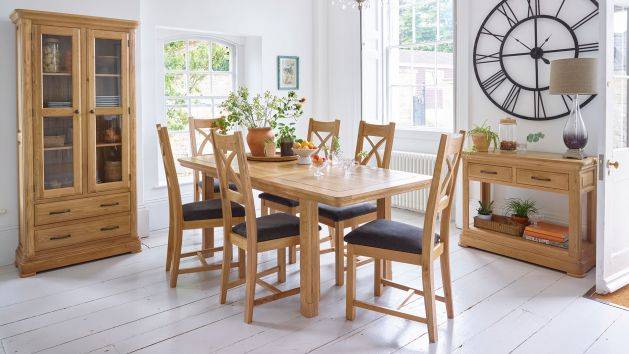The decor style of a room is defined by a number of things—the colors, the patterns, the era and style of the accessories, and more. But the room itself is mostly defined by the furniture that we choose to put in it. Sofas, coffee tables, and love seats make a living room, beds make a bedroom, and dining furniture makes a dining room. More often than not dining room furniture will consist of a table, chairs, and a buffet or sideboard. Depending on the size of the room there can be more pieces, but very rarely is there less. Buying the right dining room furniture is a big part of getting the look that you want and the functionality that you need. And a big part of your dining room set is going to be getting the right buffet or sideboard.
The purpose of a buffet or sideboard is to provide storage for extra dishes, flatware, and linens, and also to serve as a surface area for placing dishes of food and/or decorative accents. There are any number of shapes, styles and, most importantly, eras to choose from when picking this type of furniture. Whether it’s the large and ornately carved pieces of the Victorian era or the streamlined, minimalist shapes that defined the mid-century modern period, when it comes to sideboards and buffet furniture, there’s no end to your options. Here are a few things to consider when looking for your next dining room find:
Buffet and Sideboard Styles
Buffets and sideboards (the two terms are used interchangeably at times because they’re the same thing) are available in a huge variety of styles. From French country to classic Georgian, to urban contemporary, no matter what your style you’ll be able to find a piece to suit. Just be sure to get something that will fulfill your needs, whether it’s a particular style, a certain amount of storage, or some other criteria.
Keep in mind that you can also use a different piece of furniture in place of a traditional sideboard or buffet. If you have a chest of drawers or console table that looks good and serves your needs don’t be afraid to use it.
Open vs. Closed Storage
Many people err on the side of formal when it comes to dining room furniture, and if this is the case, it might be a better idea to go with closed storage (meaning a piece with solid doors). Closed storage is also easier because you don’t have to worry about displaying the items within nicely. You can leave it a mess and close the doors.
A sideboard or buffet that consists of open shelving is airier and has a lighter feeling than a heavy, closed piece, but should you choose to use one keep in mind that you’ll have to keep the things stored on the shelves looking nice. Given that people’s formal china and linens are often very nice, this isn’t necessarily a tough thing to do, but keep it in mind when shopping.
If you’re having a tough time deciding between the two you might want to consider a piece with glass doors. They’re not as visually heavy as solid doors, and they still cover some of the items inside, so you get the best of both worlds.
Size Considerations
Dining room furniture is often available in sets, and if you choose to purchase one, you won’t have to worry about the sizes not relating to each other. However, if you prefer a more eclectic look, you’ll want to be sure that the pieces work together in scale, if not in style. When purchasing a sideboard or buffet remember that it should be a bit higher than the dining room table. The most common height is 36 inches.
Widths and depths of dining room buffets will vary, but make sure that it balances with everything else in the room. A huge table accompanied by a small buffet will look a bit disjointed, as will a small table with a very large buffet.
The most important thing to do when choosing dining room furniture, whether it’s a sideboard or something else is to make sure that it’s functional for your household and serves your needs.
Source: thespruce.com

